Heat Flux and Thermal Characteristics of Electrically Heated Windows: A Case Study
Abstract
1. Introduction
2. Methodology
2.1. Overview of Heated Window Systems
2.2. Method and Process
2.3. Description of the Heated Window System Applied to a Zero-Energy House
2.4. Temperature and Heat Flux Measurement
2.5. Measurement Procedure and Outdoor Conditions
3. Results and Discussion
3.1. Effect of the Setpoint Temperature
3.2. Comprehensive Analysis
3.3. Heated Window Heat Flux Patterns
4. Conclusions
- A comparison of the orientation of the heated window revealed that the south-facing heated window located in the living room, with high irradiation and many internal heating elements, required smaller energy input. However, the measured heat gain ratio was higher for the north-facing heated window in the utility room.
- There was no significant difference in the heat gain ratio according to the operating temperature for either the south-facing or north-facing heated window. However, a reduction in the operating temperature by 3 °C reduced the input energy by up to 44.6% for the south-facing heated window and up to 41.3% for the north-facing heated window.
- The heated windows operated at a much higher temperature than the setpoint temperature due to the position of the temperature sensor for heated window control. A temperature difference of approximately 7 °C or more was observed between the position of the temperature sensor used to determine the on/off status of the heated window and the center of the glass where sensors were installed for the experiments in both January and February. No condensation problem was observed because temperatures were maintained at approximately 20 °C higher than the average dew point of the glass surface for both the south-facing and north-facing heated windows. This indicates when installing a heated window for the primary purpose of preventing condensation, it is necessary to derive an appropriate set temperature to prevent excessive energy consumption.
- Three heat flux patterns of the heated window were observed each day. In pattern (a), the efficiency increased as the outdoor air temperature decreased. In pattern (b), the efficiency increased as the outdoor air temperature increased. In pattern (c), which was observed during the daytime, the heat flow was unstable, and no correlation was observed with the outdoor air temperature. These daily patterns occurred in both January and February.
Author Contributions
Funding
Institutional Review Board Statement
Informed Consent Statement
Data Availability Statement
Conflicts of Interest
Nomenclature
| D.P. | dew point [°C] |
| HW | heated window |
| on | heating on |
| off | heating off |
| input power for window heating [W/m2] | |
| inside surface heat flux [W/m2] | |
| outside surface heat flux [W/m2] | |
| south-facing heated window | |
| north-facing heated window | |
| indoor air temperature [°C] | |
| inner surface temperature of glass [°C] | |
| inner surface air temperature (at a distance of 5 cm from the glass) [°C] | |
| outdoor air temperature [°C] | |
| outer surface temperature of glass [°C] | |
| setpoint temperature for heated window control [°C] | |
| temperature difference [°C] | |
| efficiency of heated window; heat gain ratio [%] |
References
- Wang, L.; Greenberg, S. Window operation and impacts on building energy consumption. Energy Build. 2015, 92, 313–321. [Google Scholar] [CrossRef]
- Elsadek, M.; Liu, B.; Xie, J. Window view and relaxation: Viewing green space from a high-rise estate improves urban dwellers’ wellbeing. Urban. For. Urban Green. 2020, 55, 126846. [Google Scholar] [CrossRef]
- Persson, M.L.; Roos, A.; Wall, M. Influence of window size on the energy balance of low energy houses. Energy Build. 2006, 38, 181–188. [Google Scholar] [CrossRef]
- Badescu, V.; Staicovici, M.D. Renewable energy for passive house heating: Model of the active solar heating system. Energy Build. 2006, 38, 129–141. [Google Scholar] [CrossRef]
- Arici, M.; Karabay, H.; Kan, M. Flow and heat transfer in double, triple and quadruple pane windows. Energy Build. 2015, 86, 394–402. [Google Scholar] [CrossRef]
- Werner, A.; Roos, A. Condensation tests on glass samples for energy efficient windows. Sol. Energy Mater. Sol. Cells 2007, 91, 609–615. [Google Scholar] [CrossRef]
- Werner, A.; Roos, A. Simulations of coatings to avoid external condensation on low U-value windows. Opt. Mater. (Amst). 2008, 30, 968–978. [Google Scholar] [CrossRef]
- Kim, J.; Kim, T.; Leigh, S.B. Double window system with ventilation slits to prevent window surface condensation in residential buildings. Energy Build. 2011, 43, 3120–3130. [Google Scholar] [CrossRef]
- Cuce, E. Role of airtightness in energy loss from windows: Experimental results from in-situ tests. Energy Build. 2017, 139, 449–455. [Google Scholar] [CrossRef]
- Jiang, W.; Liu, B.; Zhang, X.; Zhang, T.; Li, D.; Ma, L. Energy performance of window with PCM frame. Sustain. Energy Technol. Assess. 2021, 45, 101109. [Google Scholar] [CrossRef]
- Lechowska, A.A.; Schnotale, J.A.; Baldinelli, G. Window frame thermal transmittance improvements without frame geometry variations: An experimentally validated CFD analysis. Energy Build. 2017, 145, 188–199. [Google Scholar] [CrossRef]
- Khetib, Y.; Alotaibi, A.A.; Alshahri, A.H.; Rawa, M.; Cheraghian, G.; Sharifpur, M. Impact of phase change material on the amount of emission in the double-glazed window frame for different window angles. J. Energy Storage 2021, 44, 103320. [Google Scholar] [CrossRef]
- Simko, T.; Moore, T. Optimal window designs for Australian houses. Energy Build. 2021, 250, 111300. [Google Scholar] [CrossRef]
- Ge, H.; Fazio, P. Experimental investigation of cold draft induced by two different types of glazing panels in metal curtain walls. Build. Environ. 2004, 39, 115–125. [Google Scholar] [CrossRef]
- Zhang, E.; Duan, Q.; Wang, J.; Zhao, Y.; Feng, Y. Experimental and numerical analysis of the energy performance of building windows with solar NIR-driven plasmonic photothermal effects. Energy Convers. Manag. 2021, 245, 114594. [Google Scholar] [CrossRef]
- Ihm, P.; Park, L.; Krarti, M.; Seo, D. Impact of window selection on the energy performance of residential buildings in South Korea. Energy Policy 2012, 44, 1–9. [Google Scholar] [CrossRef]
- Malvoni, M.; Baglivo, C.; Congedo, P.M.; Laforgia, D. CFD modeling to evaluate the thermal performances of window frames in accordance with the ISO 10077. Energy 2016, 111, 430–438. [Google Scholar] [CrossRef]
- Gläser, H.J.; Ulrich, S. Condensation on the outdoor surface of window glazing—Calculation methods, key parameters and prevention with low-emissivity coatings. Thin. Solid Films 2013, 532, 127–131. [Google Scholar] [CrossRef]
- Shin, M.S.; Rhee, K.N.; Yu, J.Y.; Jung, G.J. Determination of equivalent thermal conductivity of window spacers in consideration of condensation prevention and energy saving performance. Energies 2017, 10, 717. [Google Scholar] [CrossRef]
- Jeong, C.H.; Yeo, M.S.; Kim, K.W. Experimental study on insulation performance and condensation characteristics of a vacuum insulated glass window. J. Asian Archit. Build. Eng. 2015, 14, 717–724. [Google Scholar] [CrossRef][Green Version]
- Saadatian, S.; Freire, F.; Simões, N. Embodied impacts of window systems: A comparative assessment of framing and glazing alternatives. J. Build. Eng. 2021, 35. [Google Scholar] [CrossRef]
- Jammulamadaka, H.S. Evaluation of Energy Efficiency Performance of Heated Windows; West Virginia University: Morgantown, WV, USA, 2017. [Google Scholar] [CrossRef]
- Kurnitski, J.; Jokisalo, J.; Palonen, J.; Jokiranta, K.; Seppänen, O. Efficiency of electrically heated windows. Energy Build. 2004, 36, 1003–1010. [Google Scholar] [CrossRef]
- Moreau, A.; Sc, M.A.; Sansregret, S.; Sc, E.M.A.; Fournier, M.; Sc, M.A. Modeling and Study of the Impacts of Electrically Heated Windows on the Energy Needs of Buildings. Int. Conf. HEAT Transf. Therm. Eng. Environ. 2008, 76–83. [Google Scholar]
- Cakó, B.; Lovig, D.; Ózdi, A. Measuring the effects of heated windows on thermal comfort. Pollack Period. 2021, 1–6. [Google Scholar] [CrossRef]
- Kaboré, M.; Michaux, G.; Le Dréau, J.; Salagnac, P.; Greifet, R. Parametric study of the thermal performance of a single-family house equipped with an airflow window integrating a heated glazing. Build. Simul. Conf. Proc. 2019, 3, 2019–2025. [Google Scholar] [CrossRef]
- Tällberg, R.; Jelle, B.P.; Loonen, R.; Gao, T.; Hamdy, M. Comparison of the energy saving potential of adaptive and controllable smart windows: A state-of-the-art review and simulation studies of thermochromic, photochromic and electrochromic technologies. Sol. Energy Mater. Sol. Cells 2019, 200, 109828. [Google Scholar] [CrossRef]
- Heiz, B.P.V.; Su, L.; Pan, Z.; Wondraczek, L. Fluid-Integrated Glass–Glass Laminate for Sustainable Hydronic Cooling and Indoor Air Conditioning. Adv. Sustain. Syst. 2018, 2, 1–8. [Google Scholar] [CrossRef]
- Leem, D.S.; Edwards, A.; Faist, M.; Nelson, J.; Bradley, D.D.C.; De Mello, J.C. Efficient organic solar cells with solution-processed silver nanowire electrodes. Adv. Mater. 2011, 23, 4371–4375. [Google Scholar] [CrossRef]
- Wang, Y.; Du, D.; Yang, X.; Zhang, X.; Zhao, Y. Optoelectronic and electrothermal properties of transparent conductive silver nanowires films. Nanomaterials 2019, 9, 904. [Google Scholar] [CrossRef] [PubMed]
- Kim, K.; Hong, Y.; Application, F.; Data, P. Heating Glass and Manufacturing Method Thereof. U.S. Patent 8,916,805, 12 December 2014. [Google Scholar]
- Yu, W.; Sisi, L.; Haiyan, Y.; Jie, L. Progress in the functional modification of graphene/graphene oxide: A review. RSC Adv. 2020, 10, 15328–15345. [Google Scholar] [CrossRef]
- Chen, X.D.; Chen, Z.; Jiang, W.S.; Zhang, C.; Sun, J.; Wang, H.; Xin, W.; Lin, L.; Priydarshi, M.K.; Yang, H. mfl. Fast Growth and Broad Applications of 25-Inch Uniform Graphene Glass. Adv. Mater. 2017, 29, 1–9. [Google Scholar] [CrossRef]
- Tiwari, S.K.; Sahoo, S.; Wang, N.; Huczko, A. Graphene research and their outputs: Status and prospect. J. Sci. Adv. Mater. Devices 2020, 5, 10–29. [Google Scholar] [CrossRef]
- Yoo, B.; Han, S. Low-resistance Transparent Plane Heating System using CVD Graphene Key Words: CVD graphene, transparent plane heating system, PWM control, 4-layer Graphene. Korea Inf. Electron. Commun. Technol. 2019, 12, 218–223. [Google Scholar]
- Lee, H.; Choi, M.; Lee, R.; Kim, D.; Yoon, J. Energy performance evaluation of a plus energy house based on operational data for two years: A case study of an all-electric plus energy house in Korea. Energy Build. 2021, 252, 111394. [Google Scholar] [CrossRef]
- eko-eu.com. Available online: https://eko-eu.com/products/material-analysis/heat-flux-sensors/mf-200-heat-flux-sensor (accessed on 10 December 2021).
- ISO 9869-1:2014(E), ISO INTERNATIONAL STANDARD Thermal Insulation—Building. Available online: https://www.iso.org/standard/59697.html (accessed on 10 December 2021).
- Kingsley, E.; Samuel, O.; Isaac, C.; Esosa, E. Approximation of the Dew Point Temperature Using a Cost Effective Weather Monitoring System. Phys. Sci. Int. J. 2017, 14, 1–6. [Google Scholar] [CrossRef]
- WORLD MAPS OF KÖPPEN-GEIGER CLIMATE CLASSIFICATION Tilgjengeleg på. Available online: http://koeppen-geiger.vu-wien.ac.at/present.htm (accessed on 10 December 2021).
- Chen, D.; Chen, H.W. Using the Köppen classification to quantify climate variation and change: An example for 1901–2010. Environ. Dev. 2013, 6, 69–79. [Google Scholar] [CrossRef]
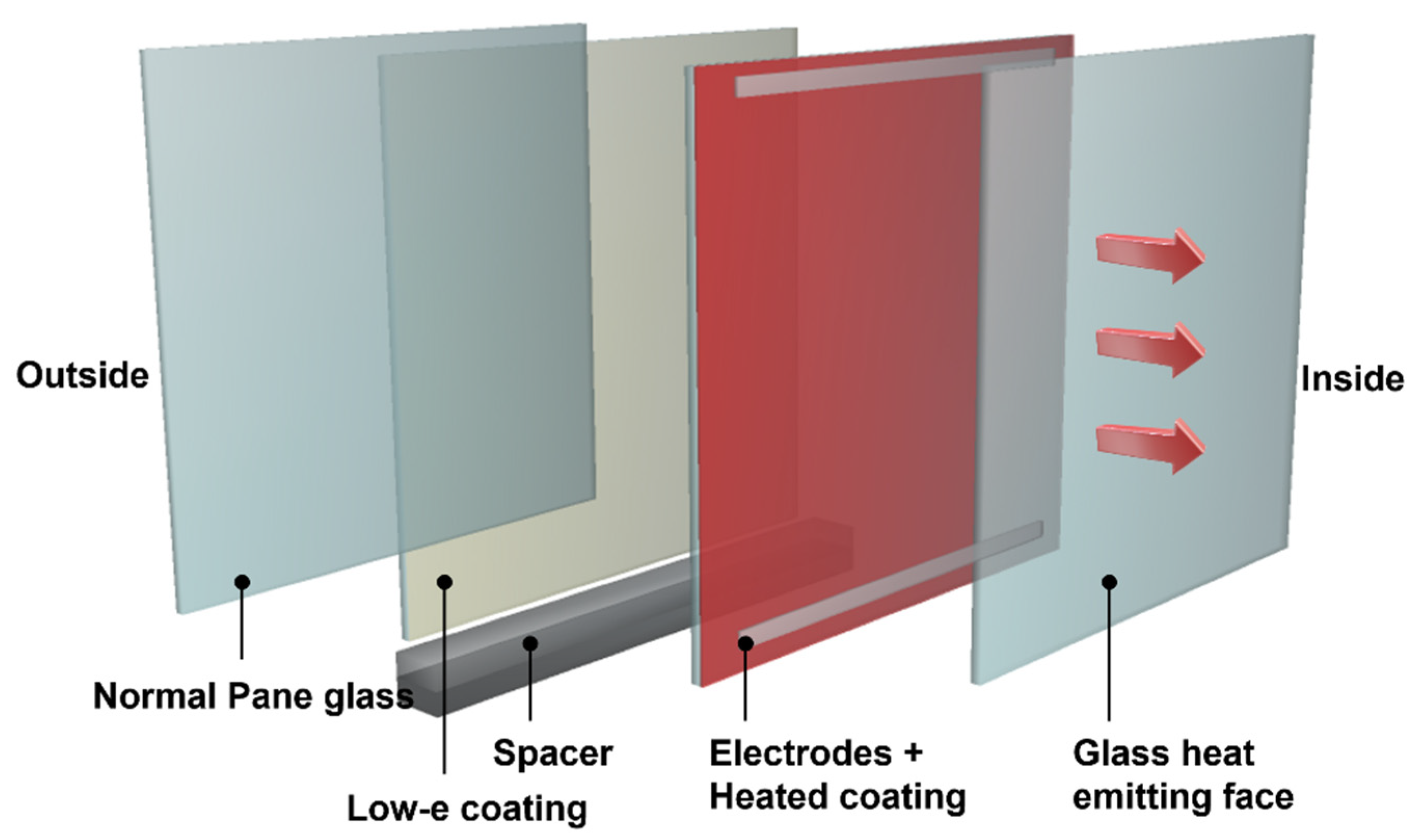

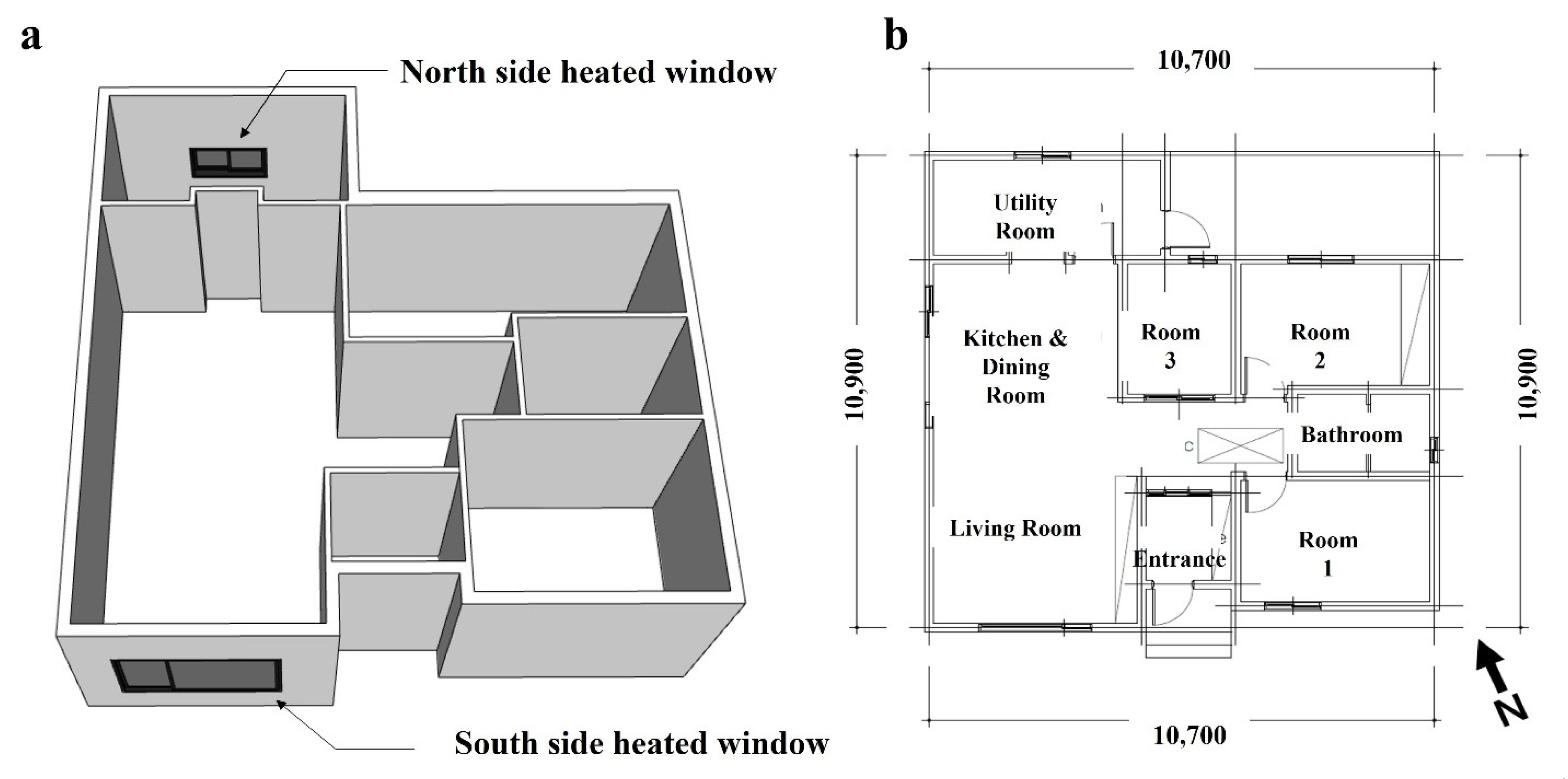
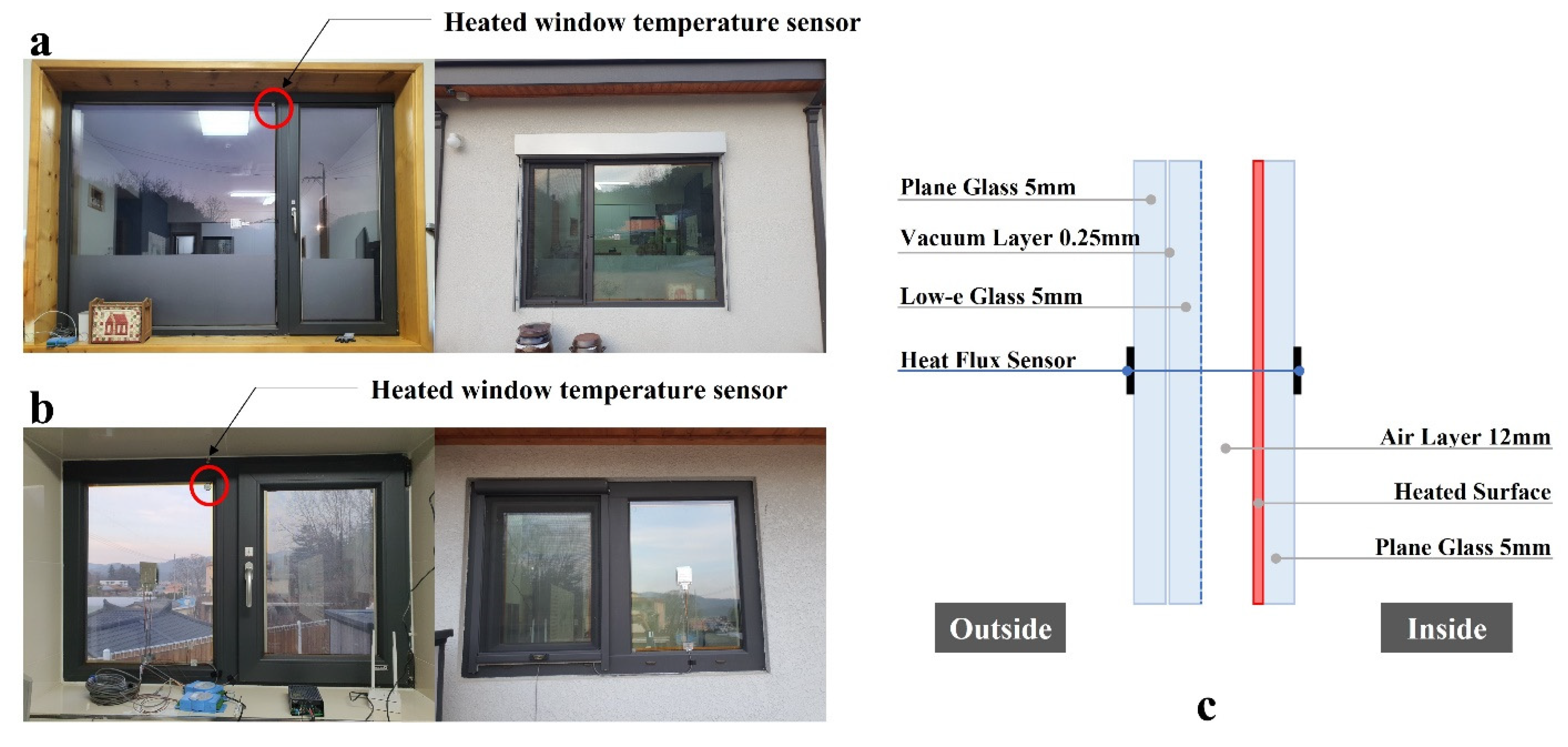
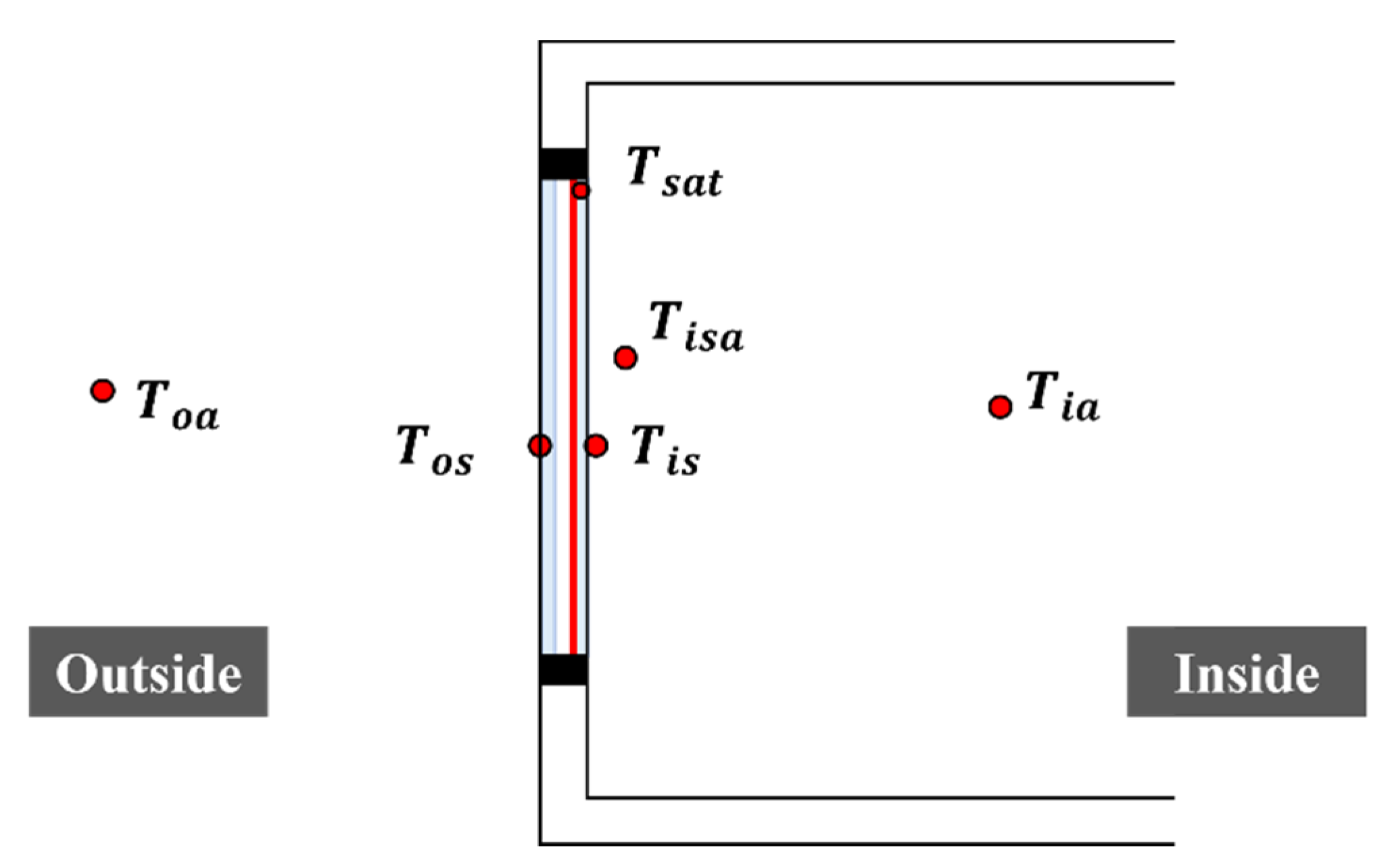




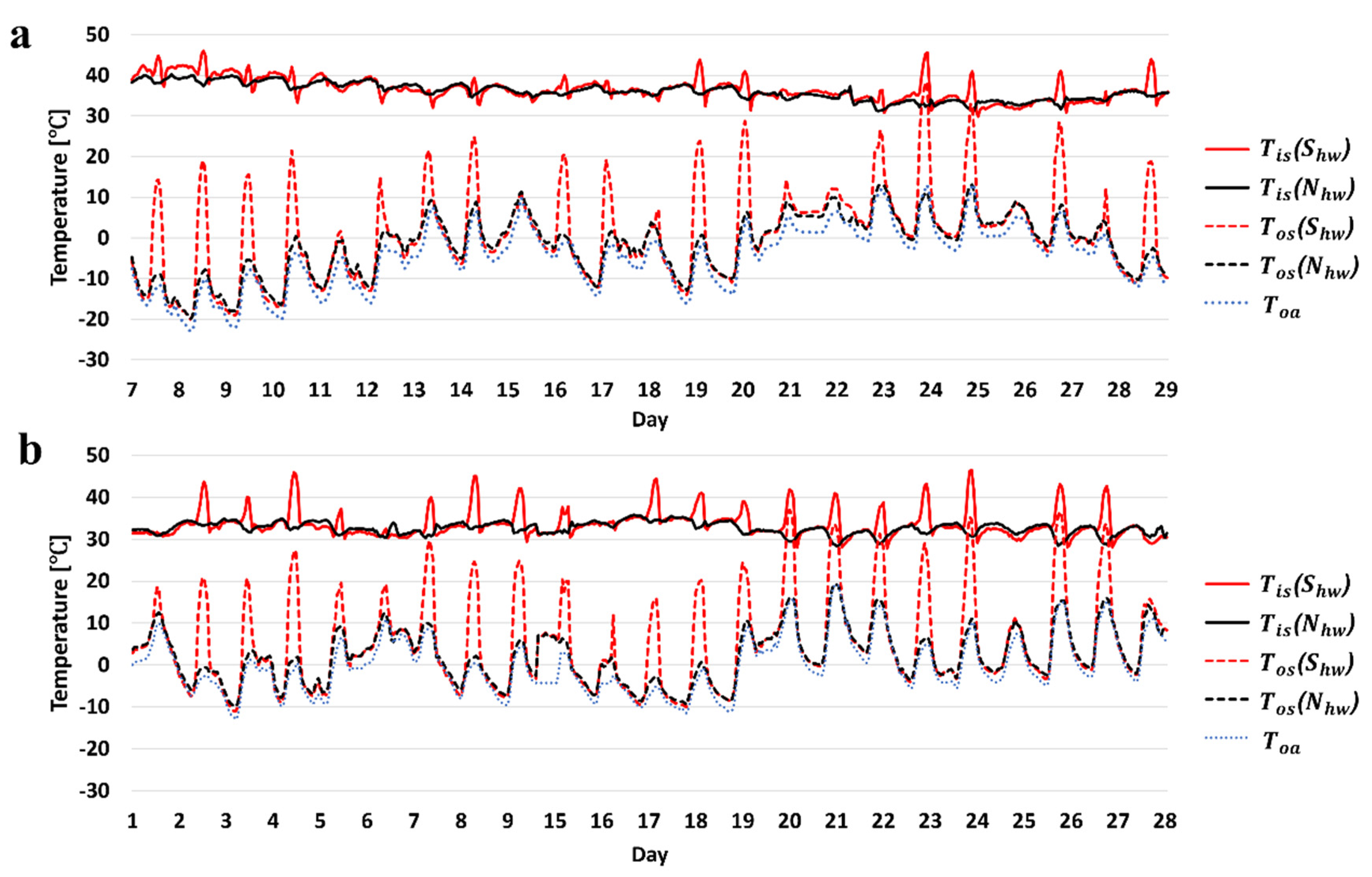




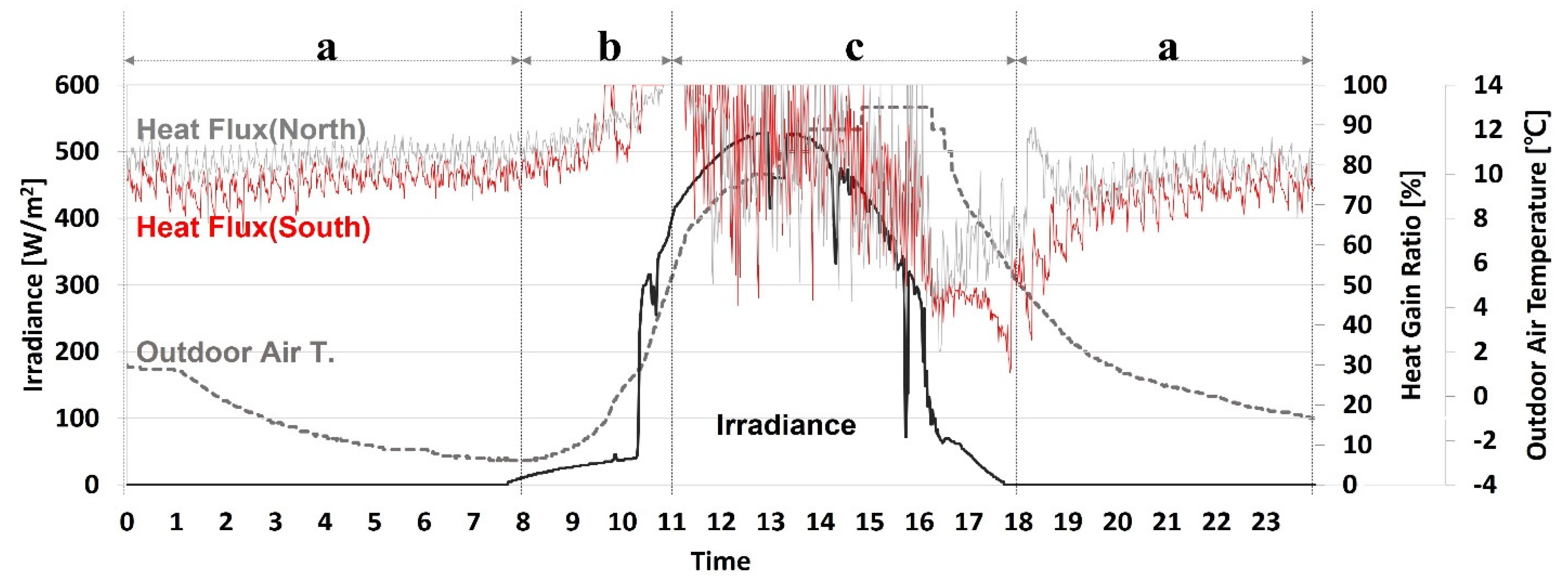
| Characteristics | Low Thermal Resistance (Thin Type) Compact |
|---|---|
| Operation temperature (°C) | −20 to +120 (sensor); −25 to +60 (cable) |
| General sensitivity (mV/W·m−2) | 0.006 |
| Repeatability (%) | ±2 |
| Internal resistance (Ω) | 15–30 |
| Thermal resistance (m2·°C/W) | 3.04 × 10−3 |
| Dimensions (mm) | 50 × 50 × 0.7 |
| Month | Case | (°C) | Measurement Period (days) | Rated Power (W) |
|---|---|---|---|---|
| January | 1 | 30 | 7 | 300 |
| 2 | 29 | 7 | ||
| 3 | 28 | 7 | ||
| February | 4 | 27 | 28 | 300 |
| Period | [°C] | [°C] | [°C] | D.P [°C] | |||
|---|---|---|---|---|---|---|---|
| Case 1 south-facing window | daytime | 97.4 | −32.9 | 38.0 | 29.7 | 28.6 | 16.9 |
| nighttime | 115.7 | −31.9 | 38.6 | 29.1 | 28.2 | 17.0 | |
| all day | 107.6 | −32.4 | 38.4 | 29.3 | 28.4 | 16.9 | |
| Case 1 north-facing window | daytime | 141.6 | −24.4 | 37.5 | 24.0 | 20.1 | 16.4 |
| nighttime | 149.1 | −28.8 | 38.2 | 24.0 | 20.0 | 15.7 | |
| all day | 145.8 | −26.8 | 37.9 | 24.0 | 20.1 | 16.0 | |
| Case 2 south-facing window | daytime | 90.7 | −27.0 | 36.6 | 28.9 | 27.1 | 16.0 |
| nighttime | 95.3 | −26.4 | 36.4 | 28.4 | 27.1 | 15.7 | |
| all day | 93.2 | −27.7 | 36.5 | 28.6 | 27.1 | 15.8 | |
| Case 2 north-facing window | daytime | 126.0 | −21.2 | 35.5 | 23.2 | 19.7 | 14.1 |
| nighttime | 129.1 | −24.1 | 36.2 | 23.6 | 20.1 | 14.1 | |
| all day | 127.7 | −22.7 | 35.8 | 23.4 | 19.9 | 14.1 | |
| Case 3 south-facing window | daytime | 68.8 | −24.5 | 35.3 | 29.3 | 28.7 | 17.1 |
| nighttime | 65.6 | −23.2 | 33.9 | 28.3 | 28.5 | 15.6 | |
| all day | 67.1 | −23.8 | 34.6 | 28.8 | 28.6 | 16.3 | |
| Case 3 north-facing window | daytime | 88.8 | −18.0 | 33.4 | 24.5 | 23.3 | 18.7 |
| nighttime | 95.0 | −21.0 | 34.0 | 24.5 | 23.1 | 18.3 | |
| all day | 92.2 | −19.6 | 33.7 | 24.5 | 23.2 | 18.5 | |
| Case 4 south-facing window | daytime | 72.0 | −26.1 | 34.8 | 28.9 | 28.2 | 16.5 |
| nighttime | 58.4 | −22.0 | 32.5 | 27.4 | 28.2 | 14.2 | |
| all day | 65.0 | −24.0 | 33.6 | 28.1 | 28.2 | 15.3 | |
| Case 4 north-facing window | daytime | 83.6 | −15.6 | 32.1 | 23.6 | 23.0 | 18.3 |
| nighttime | 93.2 | −20.3 | 33.1 | 23.8 | 23.0 | 19.2 | |
| all day | 88.5 | −18.0 | 32.6 | 23.7 | 23.0 | 18.8 |
Publisher’s Note: MDPI stays neutral with regard to jurisdictional claims in published maps and institutional affiliations. |
© 2022 by the authors. Licensee MDPI, Basel, Switzerland. This article is an open access article distributed under the terms and conditions of the Creative Commons Attribution (CC BY) license (https://creativecommons.org/licenses/by/4.0/).
Share and Cite
Lee, R.; Kang, E.; Lee, H.; Yoon, J. Heat Flux and Thermal Characteristics of Electrically Heated Windows: A Case Study. Sustainability 2022, 14, 481. https://doi.org/10.3390/su14010481
Lee R, Kang E, Lee H, Yoon J. Heat Flux and Thermal Characteristics of Electrically Heated Windows: A Case Study. Sustainability. 2022; 14(1):481. https://doi.org/10.3390/su14010481
Chicago/Turabian StyleLee, Ruda, Eunho Kang, Hyomun Lee, and Jongho Yoon. 2022. "Heat Flux and Thermal Characteristics of Electrically Heated Windows: A Case Study" Sustainability 14, no. 1: 481. https://doi.org/10.3390/su14010481
APA StyleLee, R., Kang, E., Lee, H., & Yoon, J. (2022). Heat Flux and Thermal Characteristics of Electrically Heated Windows: A Case Study. Sustainability, 14(1), 481. https://doi.org/10.3390/su14010481






